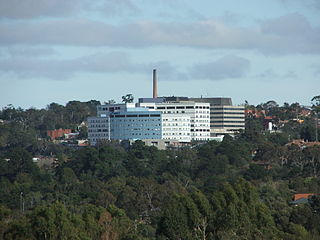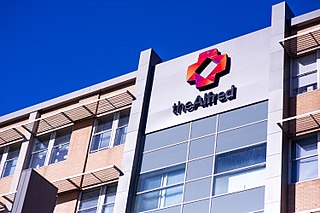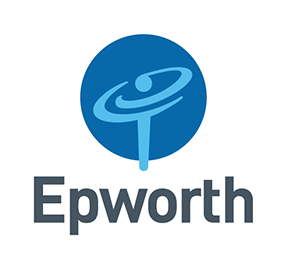
Parkville is an inner-city suburb in Melbourne, Victoria, Australia, 3 km (1.9 mi) north of Melbourne's Central Business District, located within the Cities of Melbourne and Merri-bek local government areas. Parkville recorded a population of 7,074 at the 2021 census.

Monash Medical Centre (MMC) is a teaching hospital in Melbourne, Australia. It provides specialist tertiary-level healthcare to the Melbourne's south-east.

WEHI, previously known as the Walter and Eliza Hall Institute of Medical Research, and as the Walter and Eliza Hall Institute, is Australia's oldest medical research institute. Sir Frank Macfarlane Burnet, who won the Nobel Prize in 1960 for his work in immunology, was director from 1944 to 1965. Burnet developed the ideas of clonal selection and acquired immune tolerance. Later, Professor Donald Metcalf discovered and characterised colony-stimulating factors. As of 2015, the institute hosted more than 750 researchers who work to understand, prevent and treat diseases including blood, breast and ovarian cancers; inflammatory diseases (autoimmunity) such as rheumatoid arthritis, type 1 diabetes and coeliac disease; and infectious diseases such as malaria, HIV and hepatitis B and C.

The Royal Melbourne Hospital (RMH), located in Parkville, Victoria, an inner suburb of Melbourne, is one of Australia's leading public hospitals. It is a major teaching hospital for tertiary health care with a reputation in clinical research. The hospital is managed as part of Melbourne Health which comprises the Royal Melbourne Hospital, North West Dialysis Service and North Western Mental Health. The Royal Melbourne Hospital appointed Professor Shelley Dolan as the new Chief Executive following an international search. She succeeded Professor Christine Kilpatrick AO, who stepped down on 30 June 2023.

The Austin Hospital is a public teaching hospital in Melbourne's north-eastern suburb of Heidelberg, and is administered by Austin Health, along with the Heidelberg Repatriation Hospital and the Royal Talbot Rehabilitation Centre.

The Alfred Hospital, also known as The Alfred or Alfred Hospital, is a leading tertiary teaching hospital in Melbourne, Victoria. It is the second oldest hospital in Victoria, and the oldest Melbourne hospital still operating on its original site. The Alfred Hospital is one of two major adult trauma centres in Victoria, and houses the largest intensive care unit in Australia. In 2021 it was ranked as one of the world's best hospitals. It is located at the corner of Commercial and Punt Roads, Prahran, opposite Fawkner Park.
Flemington Road is a major thoroughfare in the inner suburbs of North Melbourne and Parkville in Melbourne, Victoria, Australia. It runs for 2 km in a northwest–southeast direction, from the southern end of Mount Alexander Road, Flemington, to Haymarket roundabout and the northern end of Elizabeth Street, and provides a main connection between the northern arm of the CityLink tollway and Melbourne's CBD.

Epworth HealthCare is a provider of acute medical, surgical and rehabilitation services in Melbourne, Australia. The group has four divisions: Epworth Richmond, Epworth Eastern, Epworth Cliveden, Epworth Freemasons and Epworth Geelong Epworth Rehabilitation, with rehabilitation sites at Richmond, Camberwell, Brighton and Geelong, Victoria. With over 1,200 beds and more than 4,000 staff, Epworth HealthCare is Victoria's largest not-for-profit private hospital group.
Faculty of Medicine, Dentistry and Health Sciences of the University of Melbourne has the largest number of post-graduate enrolments in the University of Melbourne and also hosts the most school departments and centres of all University of Melbourne Faculties, consisting of 52 faculty sub-organisations. In 2021, Melbourne Medical School was ranked 25th in the world and second in Australia in the 2021 QS Subject Rankings.
The Mental Health Research Institute (MHRI) is a former Australian medical research institute that was focused upon improving the diagnosis, treatment and prevention of major mental disorders. The MHRI was active between 1956 and 2012, when it was merged with the Florey Neuroscience Institutes to form the Florey Institute of Neuroscience and Mental Health. Based in Melbourne, Victoria, the research efforts of the MHRI were focused on understanding schizophrenia, bipolar and major mood disorders, and Alzheimer's disease.
Prince Henry's Institute of Medical Research (PHI) was a Melbourne-based independent, not-for-profit, medical research institute based at the Monash Medical Centre in Victoria, Australia. In January 2014 it merged with the Monash Institute of Medical Research to become the Hudson Institute of Medical Research. Professor Bryan Hudson was the founding Director of Prince Henry’s Institute and founding Chair of the Department of Medicine at Monash University.
Sir Peter MacCallum was a Scottish-born Australian oncologist and the co-founder and eponym of the Peter MacCallum Cancer Centre in Melbourne.

Douglas James Hilton is an Australian molecular biologist. He is the CEO of CSIRO and immediate past Director of the Walter and Eliza Hall Institute of Medical Research in Melbourne, Australia. His research has focused on cytokines, signal transduction pathways and the regulation of blood cell formation (hematopoiesis). Hilton was the President of the Association of the Australian Medical Research Institutes (AAMRI) from 2014-16.
Ian Olver AM is an Australian medical oncologist, cancer researcher and bio-ethicist. He is a former chief executive officer of Cancer Council Australia and a noted authority and media commentator on cancer issues.
Gregory Bruce Mann is an Australian surgical oncologist.
The Robert Connor Dawes Foundation is an Australian not-for-profit organisation that facilitates funding in brain research, care and development in Australia and the United States. The foundation was created in June 2013 by Liz Dawes and Scott Dawes in memory of their son Robert Connor Dawes who died from a brain tumour in April 2013 at 18 years of age. As of July 31, 2015, they changed their name from Robert Connor Dawes Fund to Robert Connor Dawes Foundation.

The Victorian Comprehensive Cancer Centre (VCCC) is a multi-site, multi-disciplinary specialist cancer hospital and research centre located in Melbourne, Victoria, Australia. The VCCC comprises an alliance between The University of Melbourne, the Peter MacCallum Cancer Centre, Melbourne Health, the Walter and Eliza Hall Institute of Medical Research, the Royal Women's Hospital, the Royal Children's Hospital, Western Health, St Vincent's Hospital, Melbourne, Austin Health, and the Murdoch Childrens Research Institute.

The Children's Cancer Foundation is a registered Australian charity that supports children with cancer and their families.
Misty Rayna Jenkins is an Australian scientist known for her research into lymphocytes and cancer treatment.











